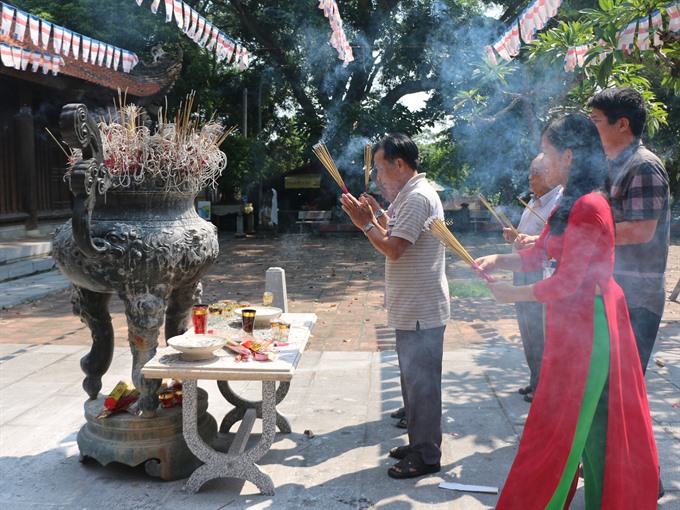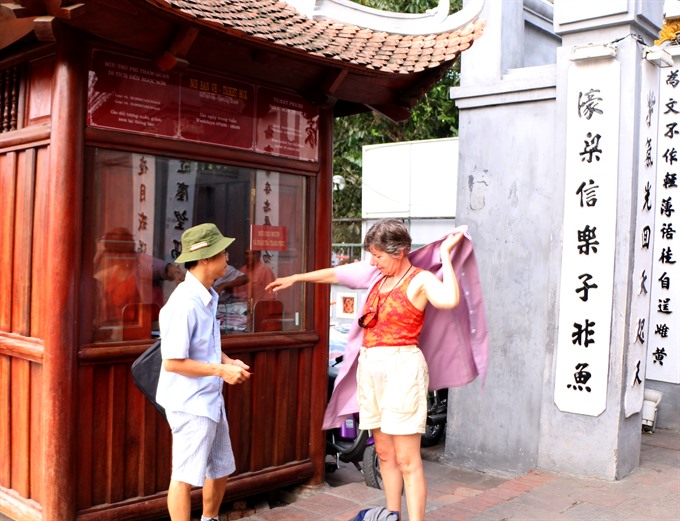 Features
Features

The capital city of Ha Noi has launched an initiative – lending visitors a longsleeved shirt or dress that stretches to below the knee, so that inappropriately clad visitors, local and foreign, can enter places of worship and other important sites with due respect for local culture and religious traditions.
 |
| Prayerful: Devout Buddhists burn incense at the Vĩnh Nghiêm pagoda in Bắc Giang Province. When Vietnamese people visit places of worship, the devotion and respect they have is reflected in what they wear. |
The capital city of Ha Noi has launched an initiative – lending visitors a longsleeved shirt or dress that stretches to below the knee, so that inappropriately clad visitors, local and foreign, can enter places of worship and other important sites with due respect for local culture and religious traditions, Hồng Vân reports.
It is a custom or a tradition, all over the world, that people dress with a certain decorum when visiting places of worship, whether they are temples and pagodas, or churches or mosques.
That decorum and respect is maintained whether one goes to pray or simply to admire the architecture or cultural aspects of the place of worship, the rituals, and so on.
In Việt Nam, pagodas and temples are places where the Buddha and various deities are worshipped. They are also places where Buddhist monks teach Buddhism, its precepts and its way of life to the devout and others who are interested in learning. They are usually tranquil, serene and solemn places.
When people visit these places, the devotion and respect they have is also reflected in what they wear.
However, there are many tourists who, either because of a lack of awareness or because of an attitude of disrespect and indifference, visit places of worship in this country wearing shorts, sleeveless shirts and other inappropriate attire.
Rather than ban such people from entering the places of worship, the capital city of Hà Nội has launched an initiative – lending visitors a long-sleeved shirt or dress that stretches to below the knee.
“I am totally OK with wearing this. When I travel to some other countries, they also offer tourists such garments. I want to make sure that I don’t disrespect the local culture,” said Pam Robertson, an Australian tourist, accepting a garment from the staff of Ngọc Sơn Temple.
“We are on a tour to Hà Nội and didn’t plan to visit the temple, so I didn’t dress properly. It’s convenient that I can borrow the long shirt here and continue my visit,” said Nguyễn Mỹ An from HCM City.
At Ngọc Sơn Temple and many other tourist attractions of Hà Nội, visitors can see a booth with a pile of neat and clean garments that staff offer to both local and international visitors who are not attired appropriately.
Temple staff guide any visitor with inappropriate attire to the booth and offer to lend them the garments for free. All they need to do is to deposit some form of ID. In general, visitors are happy to accept.
 |
| Cover up: A foreign tourist puts on a garment over her shorts and sleevless T-shirt to enter the Ngọc Sơn temple. —VNS Photos Đoàn Tùng |
According to Nguyễn Đức Vượng, head of the Ngọc Sơn Relic Site Management Board, about 100 long shirts are available for tourists to borrow everyday.
The garment, which comes in different sizes, can be worn by both men and women. They come in a light purple shade, have V shaped necks, half-sleeves and some simple patterns.
The introduction of this garment is one of several initiatives taken to implement the Code of Conduct in Public Places that municipal officials released in March. The code requires people to wear “decent” clothes in public places.
Ngọc Sơn Temple is the first place in Hà Nội to implement the initiative. It will soon be emulated at other sites, including the Temple of Literature, Kiệu Temple, former Hỏa Lò Prison and the historical relic at 48 Hàng Ngang. The style of garment offered will differ according to the nature of the site, officials said.
“It is not necessary to make the garment uniform because each region has its own cultural features and each relic has its own characteristics.
“What is the most important is that tourists understand the need to wear proper clothes in places that are deemed sacred or carry other cultural or historical importance – a custom of Việt Nam,” Phạm Trung Lương, former deputy head of Việt Nam Tourism Research and Development, told the online Dan Tri newspaper.
He also said that while there was no general standard for the garments, they must be clean and aesthetic. "Visitors cannot be asked to wear garments that smell or don’t fit," he said.
Earlier Cửa Ông Temple in the northern province of Quảng Ninh, Linh Ứng Pagoda in the central city of Đà Nẵng and the Ponagar Tower in the central city of Nha Trang had begun offering the garment. The Ponagar Tower offers about 50, while Linh Ứng Pagoda has nearly 1,000 sets of clothes for visitors to use every day. — VNS




